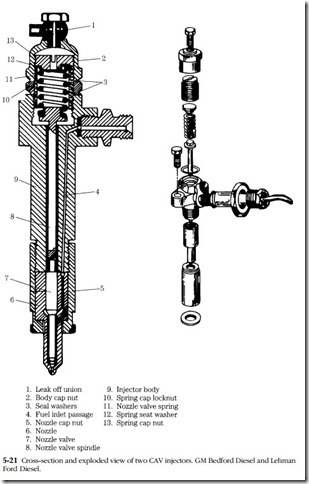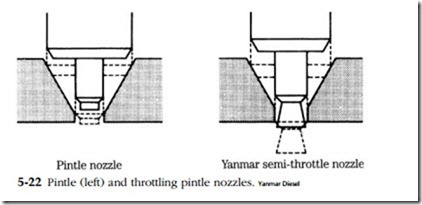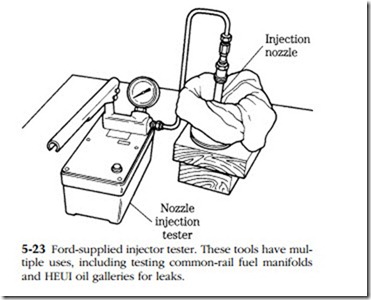Injectors
Mechanical injectors consist of two main parts—an injector body, or nozzle holder, and a needle (Fig. 5-21). The injector body secures the assembly to the cylinder head, and includes connections for fuel inlet and return lines.
A spring-loaded needle (“nozzle valve”) in the drawing, controls fuel flow through the injector. At NOP fuel pressure exerts sufficient force on the raised shoulder near the tip of the needle to overcome spring tension. The needle retracts clear of the orifice and injection commences. Once the needle lifts, its full cross-sectional area—the shoulder and tip—comes under fuel pressure. Consequently, less pressure is required to hold the needle open than to unseat it. This feature holds the nozzle open as fuel pressure drops in response to injection. When the pump plunger descends and the delivery valve closes, fuel pressure drops abruptly. The return spring forces the needle down to seal the orifice and injection ceases.
The smaller the nozzle orifice, the finer the fuel spray and, all things equal, the less ignition lag. But if too small, the orifice limits engine output by restricting fuel flow. Multi-hole nozzles, some with a dozen or more, electrically discharge, machined orifices that satisfy both flow rate and atomization requirements, have become standard on DI engines.
IDI engines employ pintle nozzles, two varieties of which are illustrated in Fig. 5-22. The pintle is an extension of the needle that, when retracted, produces a hollow, cone- shaped spray. Because of the large diameter of the orifice and the shuttle action of the pintle, these nozzles are less susceptible to carbon buildup than multi-hole types.
The throttling pintle introduces fuel in a staged sequence to reduce the sudden rise in pressure and heat during initial combustion. The pintle has a reduced diameter
on the tip that, when seated, extends into the combustion chamber. Yanmar and most other manufacturers use a throttling pintle with the tip in the form of an inverted cone, shown on the right in Fig. 5-22. During the initial phase of injection, the cone lifts so that its base almost fills the orifice. At full lift the cone retracts clear of the orifice for maximum fuel delivery.
Injector service
Regardless of the nozzle type, injectors should
• Discharge cleanly without “after-dribble,” which tends to collect in the cylinder between cycles.
• Atomize fuel for rapid combustion.
• Direct the spray into the far reaches of the cylinder, but without impinging against the piston or chamber walls.
Most malfunctions are caused by carbon buildup on the tip, which distorts the spray pattern and can sometimes stick the needle or pintle in the open position. Automatic injectors can be tested with the apparatus shown in Fig. 5-23. Similar tests
can be performed on unit injectors by loading the pump cavity with fuel and applying force to the pump plunger.
WARNING: Wear eye protection and heavy gloves when testing injectors. Fuel spray can cause blindness and blood poisoning.
There are four standard tests—spray pattern, NOP, sealing effectiveness, and chatter.
Spray pattern
Connect the tester as shown and, operating the pump lever in short, rapid strokes, observe the spray pattern. Pintle nozzles should produce a finely divided spray of uniform consistency and penetration (Fig. 5-24). Multi-hole nozzles generate a wide, fan-like pattern (Fig. 5-25). It can be helpful to direct the discharge against a piece of paper and compare the pattern to one produced by a new injector.
Nozzle opening pressure
Slowly depress the pump lever and note the peak gauge reading. Compare this pressure with the manufacturer’s NOP specification. Some specifications are fairly broad, and engines may not idle properly unless NOPs cluster at one or the other end of the specification range. Most needle-return springs can be stiffened with shims.
Sealing
Dribble standards have become tighter in recent years. The pintle injector illustrated in Fig. 5-26 should remain fuel tight under 80% of NOP for at least 10 seconds. Note and correct any other source of leakage.
Chatter
Injector opening is normally accompanied by a sharp “pop,” which suggests that the needle retracts cleanly. Verify this action as the pump lever is cycled rapidly. However, leaking injectors can be made to chatter and some perfectly good throttling pintle injectors pop open, but refuse to chatter, no matter how adroitly the pump handle is worked.


